About the theatre
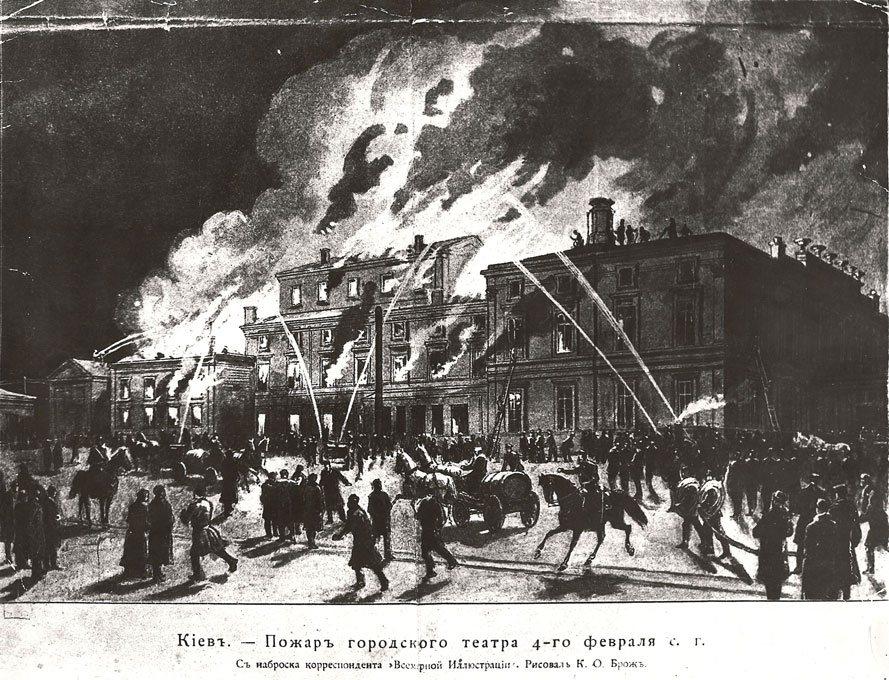 In the Kyiv center, where the city’s busiest Volodymyrs’ka and Bohdana Khmelnytskoho streets cross, right in the middle between the golden-top Sofia Kyivs’ka and the classic building of Shevchenko National University stands the so called Temple of Muses, the Kyiv’s architecture masterpiece. It bears the name of Taras Shevchenko National Opera of Ukraine.
In the Kyiv center, where the city’s busiest Volodymyrs’ka and Bohdana Khmelnytskoho streets cross, right in the middle between the golden-top Sofia Kyivs’ka and the classic building of Shevchenko National University stands the so called Temple of Muses, the Kyiv’s architecture masterpiece. It bears the name of Taras Shevchenko National Opera of Ukraine. The appearance of this magnificent construction was preceded by a misfortune. In February of 1896, after the morning performance of “Eugene Onehin” by P. Tchaikovsky, one of the dressing rooms went on fire. The fire spread in a matter of seconds and in a few hours the City theatre constructed in 1856 according to the project of architect Ivan Shtrom was burnt down to cinder.
The fire devoured one of the Russian Empire’s best music libraries, costumes and sceneries of many plays. The stage of the Empire’s third (after the Moscow and St. Petersburg theatres) regular theatre was no more. Strangely enough, this wasn’t something exceptional. Only in two years (1889-1891) 22 theatre buildings in Europe and the USA were burnt down.
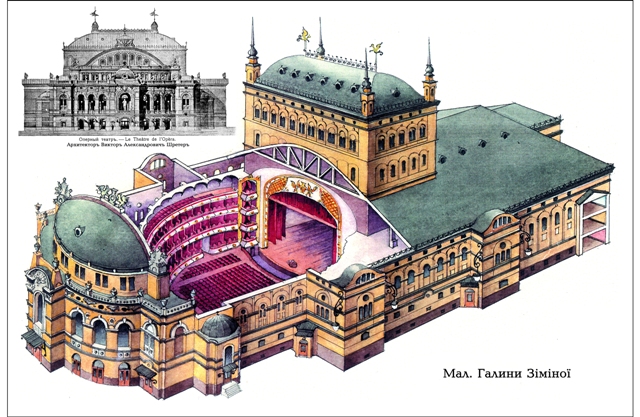
Kyiv citizens were very much fond of their cozy (featuring only 849 seats) theatre, so they demanded from the city government to build a new one as soon as possible. As it turned out, they had to wait for 5 years.
After heated discussions and arguing, the government resolved to hold an international contest for the project of Kyiv opera house. About thirty architects from Ukraine, Russia, Germany, France and Italy participated. On the 25th of February, 1897, the results of the competition were announced. The project of the imperial theatre directorate head architect Viktor Shreter was chosen as the best one.
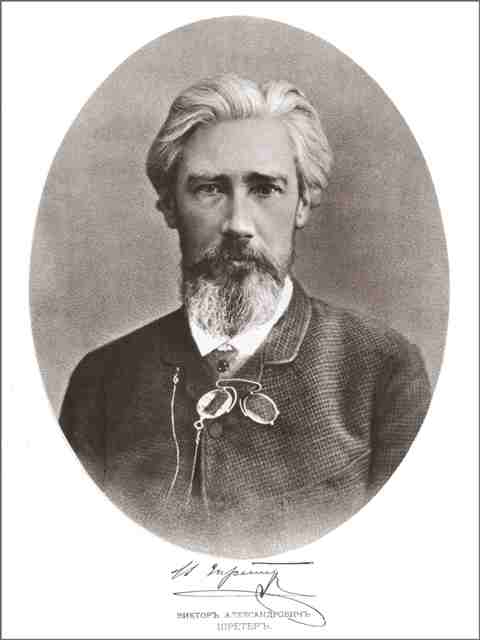 Soon Kyiv received 280 drafts that were designed in order to erect an exquisite Neo-Renaissance building. The grant for construction was given to the famous Kyiv architect Vladimir Nikolaev. In 1898 the construction works commenced under his supervision. It was planned to finish the building in two years. However, disregard all the working resources engaged (300-500 workers and 60 horses working simultaneously) it took another year to be completed.
Soon Kyiv received 280 drafts that were designed in order to erect an exquisite Neo-Renaissance building. The grant for construction was given to the famous Kyiv architect Vladimir Nikolaev. In 1898 the construction works commenced under his supervision. It was planned to finish the building in two years. However, disregard all the working resources engaged (300-500 workers and 60 horses working simultaneously) it took another year to be completed.On the 16th of September, 1901 the intrigued audience dressed in their Sunday best came to the long-awaited opening. Viktor Shreter was not among them. He deceased few months before the ceremonial consecration of the new Kyiv Opera. But his creation truly fascinated the imagination of the contemporaries! Half-oval façade richly decorated with stucco work and narrow, deep arches raise the construction upwards. Inside there are Venetian mirrors, gilding, bronze, patterned stucco of walls and ceilings, marble stairways and mosaic floors; elegant velvet armchairs and subtle Viennese lamps; a queen-lamp in the middle of the patterned ceiling…
Above the central entrance there are two winged women ascended in the air. These are the mythical patron spirits that support an artist in his good ventures. On the rooftop, right above this bas-relief there should have been the Kyiv Coat of Arms with Archangel Michael (the city’s patron) on it. However, the clergy protested, claiming that there is no way a holy warrior can be placed on such a sinful institution. The Coat of Arms was substituted by an allegoric composition – heraldic gryphons holding a lyre as a symbol of the art of music. The witnesses also say that the façade was also decorated with busts of Mikhail Glinka and Aleksandr Serov. However, they were eventually removed during the 1934 reconstruction. Yet the gryphons are still on their watch.
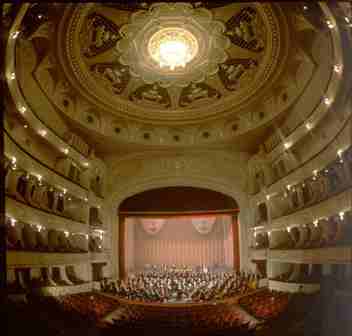
The architect was not interested solely in design rhythmics and exquisite façade details. Viktor Shreter made sure that the building is convenient for both the artists and the audience. In those days the stage of the Kyiv Opera was the biggest in the Russian Empire (width - 34,3 m, depth – 17,2 m, height – 22,7 m). Its parterre could seat 384 people. In total, the capacity of the parterre, the amphitheatre, the dress circle and four other circles of the theatre numbered 1650 seats. The theatre building had a steam-heating system, conditioning and splendid scenic equipment. Both the artists and the audience praised the theatre acoustics.
The architect felt the special atmosphere of the picturesque district around the construction site with its smooth relief transitions and lavish chestnut bloom. Shreter’s distinctive building fits well to a small square and has become itscompositional and esthetic feature. But the first responses to the master’s draft were not all positive. The Kievlyanin Newspaper referred to the building as “quite unattractive”, comparing it to “a giant clumsy tortoise”, which sits in the middle of the square. The interior was blamed of its simplicity and even poorness, although the article author also mentioned “moderate exquisiteness”.
The time marched on and history changed as well… The theatre endured the whirlpool of events, though it faced the danger of destruction several times. Its “moderate exquisiteness” nearly led it to its end during World War I, the war for independence, the rise and fall of the Ukrainian People’s Republic. Later in the 30’s the Soviet government contemplated a project of the Opera reconstruction which envisaged making the building more “proletarian-like”. Fortunately, it never happened.
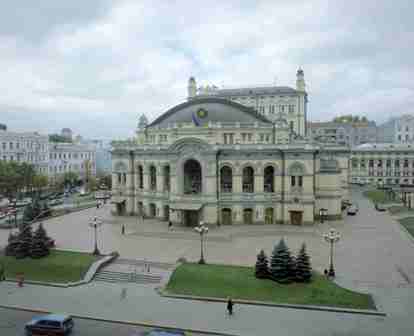 The building also survived during the horrific years of World War II. It is known that Kyiv underground planned to blow up the building to kill Nazi officers who eagerly watched the plays. On the 2nd May, 1943, the Opera was hit by a bomb, but it didn’t explode after breaking through the roof and the floor and ended up stuck in the sand that filled the basement.
The building also survived during the horrific years of World War II. It is known that Kyiv underground planned to blow up the building to kill Nazi officers who eagerly watched the plays. On the 2nd May, 1943, the Opera was hit by a bomb, but it didn’t explode after breaking through the roof and the floor and ended up stuck in the sand that filled the basement. The masterpiece of architecture proudly stood without substantial reconstruction works for more than 80 years. We can only mention the construction of two-storied annex with rehearsal halls on the rear side of the theatre in 1936. During the service period some of the constructions were demolished, the scenic equipment and mechanisms became obsolete; both the outer and inner decorations became worn out, the gilded interiors darkened. The building itself started to sink; cracks appeared in its base. In 1984-1987 the theatre underwent a complete reconstruction. Damaged after war years, the building needed a huge amount of work, which took five years to be completed. The Kyiv Opera saw the commencement of its 120th season in 1988 being completely renewed. Not only did the restorers keep the magnificent interior design, but also considerably enriched it. The foyer and the halls were renovated; the oak wardrobes were moved to the ground floor, some changes were made behind the curtains. Some rehearsal and dressing rooms were added and a choir classroom appeared. The stage became deeper (from 17 to 20 m) and higher (from 23 to 27 m). This made changing the decorations more quickly and efficiently, not only during the intermissions, but also while the play goes. The total area of the stage is now 824 sq. m. It was equipped with state-of-art mechanisms, electronics and lights of that time.
During the reconstruction works the old organ was substituted by a new one, ordered from Rieger-Kloss Company (Czech Republic). The orchestra pit can now house 100 musicians.
The total area of the theatre was increased to 60 000 square meters. 1304 people can watch the plays simultaneously. The curtains are raised almost every night to fascinate them with the miraculous world of singing and dancing forever. The Pearl of Architecture erected by Viktor Shreter has become a true Temple of Muses of theatre and ballet art.
